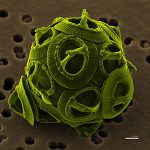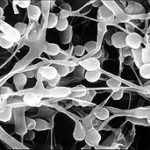There are organisms i.e. algae that can survive extreme and constantly changing environments such as externally rendered surfaces/ façades. The most important factors that control the growth of such organisms on a façade are the relative humidity and the temperature.
Fig.1: Microscopic view of an algae micro-organism

Every biological organism has different requirements for their own growth, there are some organisms that are entirely dependent on obtaining an organic carbon source from the external render substrate to which they latched on via heterotrophy which is simlar to humans, mammals and insects on a food chain where they consume other organisms as a source of energy. Others organisms are capable of using atmospheric CO2 as a carbon source to generate energy for its own use as well as for consumption of the other organisms via a process known as autotrophy. The autotrophic organisms have a great resemblance to plants in the food chain of a typical ecosystem as plants convert the sunlight energy into chemical energy to be used by it as well as the other organisms that feed/ depend on it for survival.
Specifically, algae and some bacteria convert sun light to chemical energy by photosynthesis (phototrophy).
Organisms like fungi that have features similar to human animal cells use (organic) chemical compounds as energy source just like animals (chemotrophy).
Fig.2: A micro-scopic view of fungi micro-organisms

The most typical characteristic for all microorganisms growing on external render/ façades is their ability to endure repeated cycles of drying and rehydration.
When we find microorganisms growing on a façade, we actually have the presence of a biofilm which contain active and dormant microorganisms and products of their metabolism e.g. acids and polymeric materials often polysaccharides (molecules present in sugar).
The weathering of rendering materials is accelerated by the presence of a biofilm as biofilm acts like trapped water, expanding and gradually undermining the structure of the wall from within. The biofilm is highly diverse in both space and time. The polymeric material (a large, long, self-repeating molecule) acts as a glue due to its chemical components attracting and trapping dirt from the air which the micro-organisms can use as a source of nutrition. The colonization of the external render begins with autotroph organisms permanently settling on the surface, only requiring inorganic compounds for growth such as atmospheric CO2. These organisms then create primary biofilm providing which provides necessary for heterotroph organisms to grow e.g. algae and lichen might be the primary colonizer on external building renders as they are autotrophic, they require only atmospheric CO2 and can endure long periods without water. They start growing and form the first layer of biofilm which catches dust particles and also provides nutrients for later colonizers such as bacteria and moulds which are not able to synthesise their own food from the atmosphere. Given the time and meeting certain criteria, a complex system of many different organisms in the biofilm can be formed.
Algae are a polyphyletic group (a group developed from more than one ancestral type) of eukaryotic organisms commonly considered as photosynthetic organisms except plants. Different algae have very different appearances, life-styles and tolerance of variations in temperature, moisture etc. They can be:
- aquatic, well known in freshwater and marine environments where they are completely dependent on liquid water.
- However, some algae, called terrestrial algae, can live in damp terrestrial environments as, for instance, in soil, on tree trunks or on building façades.
These algae are spread by air, and their tolerance of variation in humidity, light intensity, temperature and in aridity is very high.